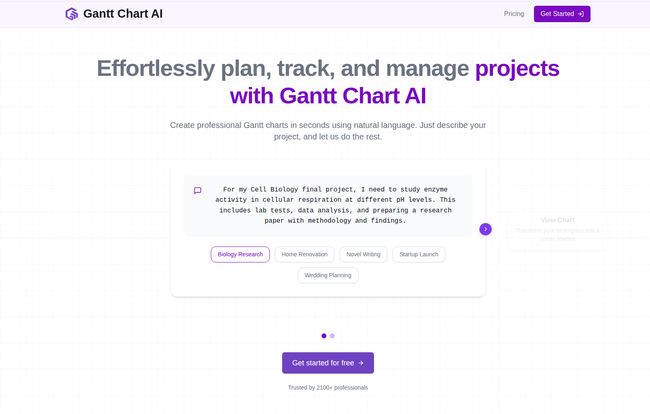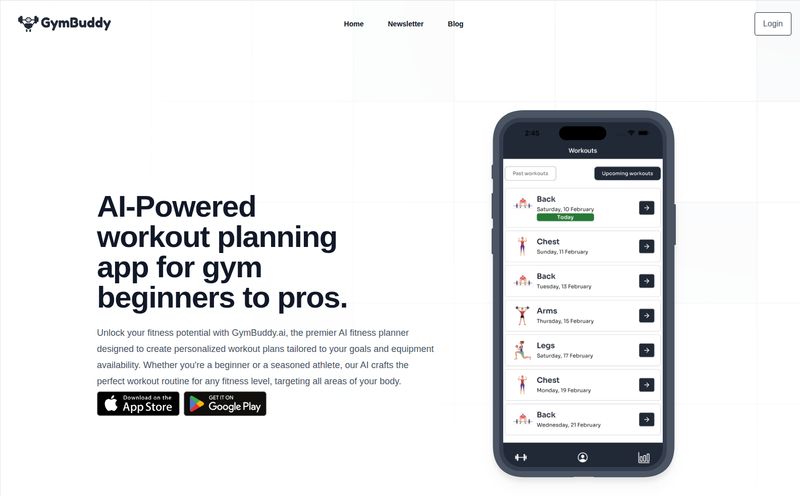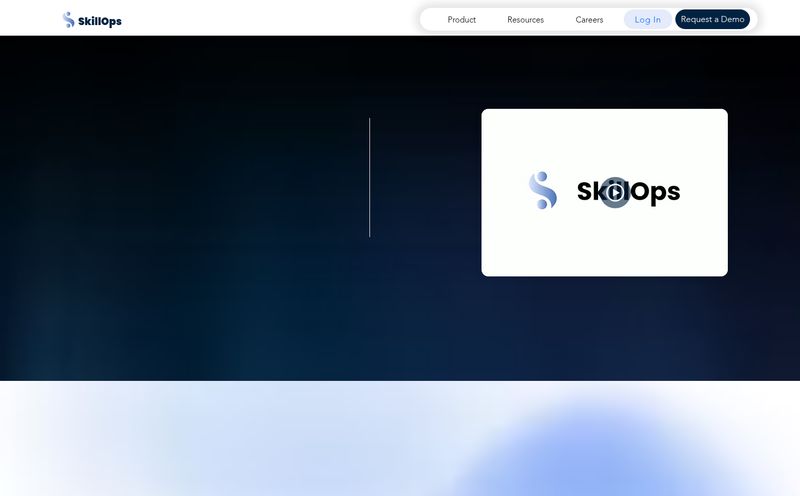If you’ve ever managed a project, you’ve probably had a love-hate relationship with Gantt charts. Mostly hate. They’re the project management equivalent of eating your vegetables: you know they’re good for you, providing structure and clarity, but man, can the process of making them be a drag.
I’ve spent more hours than I care to admit in Excel, coloring in cells to mimic a timeline, or wrestling with clunky, overpriced software that feels like it was designed in 1998. It’s a tedious, manual process that always feels like it takes longer than the first two tasks on the chart itself. So when I stumbled across a tool called Gantt Chart AI, my inner skeptic raised an eyebrow. An AI that just… makes the chart for you? By just… telling it what you want? Riiiight.
But my curiosity won out. In the SEO world, we’re constantly juggling projects—content calendars, technical audits, link-building campaigns. Anything that promises to save time is worth a look. So I decided to give it a spin. And I have some thoughts.
First, a Quick Refresher on Gantt Charts
Before we go any further, let's just quickly get on the same page. What even is a Gantt chart? Invented by Henry Gantt way back in the early 1900s, it's a visual bar chart that illustrates a project schedule. It shows you the start and end dates of all the different tasks, their dependencies, and the overall project timeline. It turns a messy list of to-dos into a clear, visual roadmap. Essential stuff, really. But the creation process has always been its Achilles' heel.
The Old Way of Project Planning
Think about how you’d normally create one. You’d open up a spreadsheet or a dedicated PM tool. You'd list every single task. Then you'd assign start dates, end dates, durations, and owners. Then you'd link dependencies, so that Task B can't start until Task A is finished. It's a digital game of Tetris, and one wrong move can throw the whole timeline out of wack. It's precise, but it's also precisely what makes it so mind-numbing.
How Gantt Chart AI Changes the Game
This is where Gantt Chart AI waltzes in and says, “There’s a better way.” Instead of you building the chart piece by piece, you just give it the blueprint in plain English. It’s like describing a Lego model to a master builder and having them construct it for you.
Just Describe Your Project
The interface is ridiculously simple. There's a box for your project name and a bigger box for the project description. And that's pretty much it. The magic is in that description box. You don't need special commands or code. You just write out your plan conversationally. Something like, “We’re launching a new podcast. First we need to brainstorm topics for two weeks. Then record the first 5 episodes over the next three weeks. Simultaneously, we need to get artwork designed, which should take a week. After recording, we’ll spend two weeks on editing and post-production before the big launch.”
Your Chart Lives in Google Sheets
This, for me, is the killer feature. After the AI does its thing (which takes, like, 10 seconds), it doesn’t trap your chart in some proprietary format. It generates a Google Sheet. Why is that amazing? Because everyone knows how to use a spreadsheet. You can easily share it with your team, make tweaks, update progress, and collaborate in real-time without having to teach anyone a new piece of software. It’s familiar territory, which lowers the barrier to entry to basically zero.
Don’t Worry Excel Fans, You’re Covered Too
While I live and breathe Google Workspace, I know there are plenty of organizations that are still firmly in the Microsoft camp. Gantt Chart AI gets this. You can also download your chart as a standard .xlsx file. So, no one gets left out of the project planning party. Even if you are still using Excel for everything.
Putting It Through Its Paces: A Real-World Test
Okay, theory is great. But does it actually work? I decided to feed it a typical SEO project plan. I typed in a detailed description of a 3-month content strategy rollout, complete with keyword research, topic clustering, content writing, editing, publishing, and promotion phases. I included dependencies, like writing can't start until the keyword research is approved.
I hit the button, held my breath, and… it worked. Shockingly well.
What popped out was a clean, organized Gantt chart in a Google Sheet. The tasks were broken down, the timelines were plotted correctly on the calendar view, and the durations were spot on. Was it 100% perfect? Not quite. I had to make one or two minor tweaks to the dates, but that took me 30 seconds in the spreadsheet. Compared to the hour I might have spent building it from scratch, it was an absolute win.
The Good, The Bad, and The Price Tag
No tool is perfect, of course. Here’s my honest breakdown after playing around with it.
What I Genuinely Liked
The sheer simplicity is the biggest plus. The barrier to getting a functional, shareable project timeline is incredibly low. The Google Sheets integration is a stroke of genius. It leverages a tool your team is already using, which is a massive advantage over standalone platforms. And the speed is undeniable. It turns a task that used to be an afternoon-killer into a two-minute job.
A Few Things to Keep in Mind
The main thing to know is that it operates on a credit system. You get a couple of free charts to try it out, but after that, you'll need to buy credits. It’s not a fully free-for-all tool, which is fair enough. Also, for hyper-complex projects with hundreds of overlapping dependencies (think building a skyscraper), you might still need the power of something like Microsoft Project. But for 95% of the projects most of us are working on? This is more than enough.
Let's Talk About Pricing
The pricing model is pretty straightforward and, in my opinion, very reasonable. It’s a pay-as-you-go system, which I much prefer over a mandatory monthly subscription I might not always use.
| Plan | Price | What You Get |
|---|---|---|
| Free Trial | FREE | 2 credits for Gantt charts, export to Google Sheets, download as Excel. |
| 30 Credits | $3 | Access to premium features, all export options, download history. Only $0.10 per chart. |
| 100 Credits | $6 | Best value. All premium features, all export options, download history. |
When you think about it, paying 10 cents to save 30-60 minutes of tedious work is a no-brainer. The return on investment is immediate. I spent more on my coffee this morning.
Who Is This Tool Really For?
I can see this being a lifesaver for a bunch of different people:
- Project Managers & Team Leads: Quickly spin up timelines for new initiatives without getting bogged down in administrative work.
- Freelancers & Consultants: Impress clients with professional-looking project plans that you created in minutes, not hours.
- Startup Founders: Map out your product roadmap or launch plan without needing to hire a dedicated project manager yet.
- Students: Easily plan out complex final year projects or group assignments. Seriously, I wish I had this in college.
Frequently Asked Questions
So what is a Gantt chart again?
It's a visual project management tool, a bar chart that shows the schedule of a project. It displays all the tasks, their start and finish dates, and how they relate to each other, giving you a clear overview of the entire project timeline.
How exactly does Gantt Chart AI simplify the planning?
It cuts out the manual labor. Instead of you building the chart by adding tasks, dates, and dependencies one-by-one in a spreadsheet, you just describe your project in plain text. The AI interprets your description and builds the entire structured chart for you automatically.
Can I export the charts to use them elsewhere?
Yes, absolutely. The primary output is a Google Sheet, which is highly versatile. You can also download a standard Excel (.xlsx) file, which makes it compatible with most business environments.
What types of projects is this best suited for?
It works brilliantly for projects with clear tasks, definable timelines, and sequential steps. Think things like software development cycles, content marketing campaigns, event planning, home renovations, or product launches. It might be less ideal for highly abstract, non-linear brainstorming work.
Is it actually free to start?
It is. You get 2 free credits when you sign up, which means you can generate two complete Gantt charts to see if it works for you before you ever have to consider paying.
How secure is my project data?
This is a valid concern with any AI tool. According to their site, you should treat it like any public AI. It's probably best not to include super-sensitive proprietary secrets in your project description. Stick to the task and timeline information.
My Final Verdict on Gantt Chart AI
So, is Gantt Chart AI the end of project planning as we know it? No, of course not. You still need to do the hard work of thinking through your project's steps and strategy. But is it the end of the tedious setup of a Gantt chart? For a huge number of cases, I think the answer is a resounding yes.
It’s a sharp, focused tool that solves one specific, very annoying problem incredibly well. It’s not trying to be an all-in-one project management suite like Asana or Monday.com, and that's its strength. It knows its job—turning your thoughts into a timeline—and it does it fast. For the price of a cheap coffee, you can buy back hours of your time. And in this business, time is the one resource you can never get more of.
Reference and Sources
- Gantt Chart AI Official Website
- Official Pricing Information
- Project Management Institute (PMI) - For general information on project management principles.




